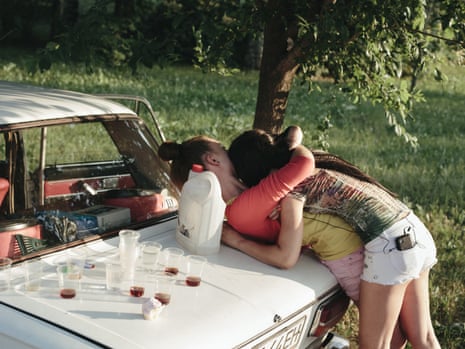I took this in Donetsk, Ukraine, in 2014, just as the war with Russia started. It was immediately after the first battle for Donetsk airport, the first time war came to the city. I was on the bus back to my apartment when I spotted this car and people having a picnic next to it. I got off, and we got talking and had a few drinks. It was a chance meeting, they were all excited to meet a foreigner – they had never met an English person before.
I was taking pictures and they were posing, just young people having fun. This shot was a snapshot, they weren’t really paying attention to me when I took it, but when I looked through my photographs later it stood out. I like the fact you can’t see the girls’ faces. I don’t know them, so I would have felt uncomfortable sharing a picture of them drinking, which might represent them negatively.
The image is just of two friends before the war turned bad, but it has become poignant. Back then no one knew what the war would turn into – no one would have believed how bad it would get and how long it would last. Maybe these girls’ lives went on as normal and they weren’t too badly affected. But it makes me think of many other friends and families I have met and known there who have gone their separate ways because people had to leave the country or because their political differences became so extreme. In that way, it reminds me of what’s happening here in the UK with Brexit. Families arguing over politics – the war around the dinner table.
I have grandparents from eastern Europe on both sidesand always felt a connection to this part of the world. In 2013, my grandmother was near the end of her life after a long battle with Alzheimer’s, and I started thinking more about Ukraine and making regular trips there.
I was in the country when the Euromaidan protests [pro-European/anti-Russian rallies] broke out and the subsequent unrest started to turn violent. I captured some of this action, but I was more interested in quieter stories. Conflict is often presented with the most dramatic imagery, condensed into a story that’s part of a news cycle. But, as you experience it, it’s much more spread out, over long periods in which there’s nothing happening – and in which life goes on.
In 2015, I spent time with a Ukrainian battalion, driving to a frontline town where there had been a battle. I was with soldiers and I kind of knew what we’d see, or what I would be allowed to see. But, on the road on the way there, I was looking out of the window at all these typical things, at old ladies selling pots of honey, thinking: “I’m just passing by all this stuff.”
At times it seemed normal to hear constant artillery and see columns of military vehicles everywhere. Now it seems crazy, but you get used to it. I wanted to show how society was affected in so many small ways by the conflict; it wasn’t just on the frontline. Many places aren’t visibly affected, but then there are a lot of displaced people, friends and family on opposite sides of the conflict, and there are towns you have known for years that from one day to the next become impossible to visit. It’s like London and Brighton suddenly being separated by a front line. It’s very complicated and confusing.
People have become so used to seeing photographs of conflict from Ukraine that those are the kind of images people associate with the country now. But I find that the pictures people respond to are those that don’t necessarily look like war, the pictures they can engage with. I hope that gets them thinking.
Borderland: Stories from Donbas by Christopher Nunn is at Impressions Gallery, Centenary Square, Bradford, until 4 January.
Christopher Nunn’s CV

Born: Huddersfield, 1983.
Studied: Photography BA at Bradford College. Worked various jobs for years before pursuing photography more seriously.
Influences: “I like the rawness of photographers such as Gordon Parks, Chris Killip, and Boris Mikhailov, how human their work is. But most of my inspiration comes from the people I meet, the stories they share, and events that happen.”
High point: “The current exhibition at Impressions Gallery. They really helped me define this work and translate it into a powerful exhibition. Meeting so many incredible people in Ukraine over the years and being able to experience a little bit of their lives has been a high point.”
Low point: “Learning to photograph again after eye injuries.”
Top tip: “Try to get to know who you are. Have fun.”

Comments (…)
Sign in or create your Guardian account to join the discussion